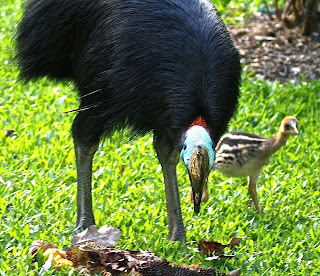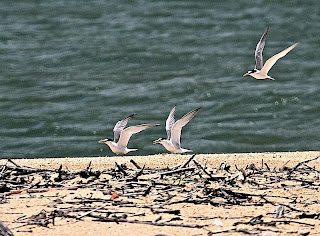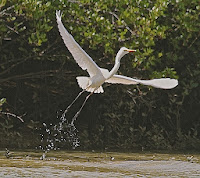
Hello from Coquette Point and a very happy Summer Solstice,
Please value every extra second of this longest day of the year. The sun rose over the Coquette Point rookery at 5.38 this morning in a blaze of colour.
It has been gardener's weather with rain falling at night, about 10 mls and mostly sunny through the day. A fresh sou-easterly is bringing cool breezes to the coast and we are experiencing very mild weather for this time of the year. While the southern cities, this week, have had heatwave conditions, temperatures over 40 in Melbourne, Adelaide and Perth.
The frogs and other rainforest creatures are responding to the increasing moisture and with every passing shower a chorus of calls springs from every corner. It's as if an unseen conductor was prompting their calls for when the showers come the white-lipped tree frogs, which have made their home in the roof downpipes, start their mating calls and the crocks are amplified in the down-pipe-organ. Then the string section of the rainforest orchestra commences with crickets calling in a continuous long high note. A distant rumble heralds the percussion and the scrub fowls are summoned into action and their loud chortles and screams punctuate the rainforest symphony. So it is tonight, and it will continue for the next three months.
Cassowary 'Q' is being harassed by 'Jessie' and she is continuously alert to Jessie's noise and smell.
At the first sign of Jessie she runs and hides in the rainforest. On Tuesday I was on my way up the track to check on the water tank on the hill and heard chasing, 'Q' as running and I saw 'Jessie' close behind. When 'Jessie' saw me she stopped and 'Q' who had hidden near the water tank peered out from behind a tree.
Looking with just one eye she watched until 'Jessie' left, all the time keeping herself concealed, but for the one eye looking. Good thinking to take the camera with me!
These are indeed wonderfully, strange creatures.

Meanwhile Jessie is enjoying the pandanus fruit which is ripe and plentiful in the swamp and smelling very sweet. When she finishes eating she will often stand with her legs crossed while the rain falls heavily on her feathers.
The Leichhardt Tree, Nauclea orientalis, fruits are ripe and falling.

 When 'Jessie' has her fill of pandanus she moves across the road to the Leichhardt Tree and always looks up to see where other birds are feeding and might knock some fruit down for her.
When 'Jessie' has her fill of pandanus she moves across the road to the Leichhardt Tree and always looks up to see where other birds are feeding and might knock some fruit down for her. When she eats all the Leichhardt fruit she moves across to the Meleleuca swamp on 27V, where there is a grove of pandanus.
When she eats all the Leichhardt fruit she moves across to the Meleleuca swamp on 27V, where there is a grove of pandanus.'Jessie' has maintained this feeding ritual all this week.

On Tuesday 'Snout' turned up with his new chick. Again he was very nervous and hungry. He was lucky to find a few wax jambus and he gobbled them up with no concern for the hungry chick. However a ripe Jackfruit had fallen from a great height and when he found it he called to the chick to join in the feast.

Across the road and the chick right beside Snout's feet.

I thought how will the chick negotiate the gutter but with a hop, the envy of a kangaroo, the little chick was down and out of the gutter in one camera click. This little chick is very strong and deeply bonded to his father.

Going to town on Thursday I saw a cassowary before the bridge. When I looked at the photos I was thrilled to see it was an old matriarch I had not seen sense before cyclone Larry, 20 March 2006.

This old girl has extremely long wattles and they are spaced apart and of equal length. When we saw her she was crossing the road looking for ripe mangoes on wild trees in the area.
She is called 'Clara' after Clara Mau. Deslie, Clara's daughter told me the cassowary had been coming around for a few weeks and was chasing the other birds in the area.
 Deslie also advised that 'Brown Cone' still had his chick, which has now lost its stripes, but best of all there is another new father with a chick, unfortunately no photos as yet. Deslie said it was a young cassowary about four years old and its chick was very small. The only cassowary I know to suit the description is 'Dot'. We will just have to wait for a photo.
Deslie also advised that 'Brown Cone' still had his chick, which has now lost its stripes, but best of all there is another new father with a chick, unfortunately no photos as yet. Deslie said it was a young cassowary about four years old and its chick was very small. The only cassowary I know to suit the description is 'Dot'. We will just have to wait for a photo.So it seems, at the moment, we have four male cassowaries with one chick each at Coquette Point. Last year only one chick survived to subadult hood, 'Little Dad's' chick and the year before 2011 no chicks survived, mainly due to cyclone Yasi.
Last week I invited you to suggest a name for cassowary 'Dad 1' and Ruth and I have agreed that Juliann Sweeney, from Adelaide, suggestion of 'Hero' was the name that best suited this great patriarch cassowary. So 'Hero' he is.
I was on the road on Thursday with Russell Constable we were headed for the mouth of Liverpool Creek at Cowley Beach. Russell, was monitoring and photographing for the Mandubarra Elders, the traditional owners of the area, and I was invited to accompany Russell.
 We were excited to see and hear the unmistakable call to the Little Tern as we arrived and observed they were fishing up Liverpool Creek, around the sand spit as well as out to sea. There was a fresh sou-easterly of 30knots blowing and I was grateful we had approached the area from the calm of the mangrove lined creek. The South Barnard Islands National Park lie off shore and the snow white, puffy cumulus clouds made patterns in the water and on the beach as they shadowed the sun.
We were excited to see and hear the unmistakable call to the Little Tern as we arrived and observed they were fishing up Liverpool Creek, around the sand spit as well as out to sea. There was a fresh sou-easterly of 30knots blowing and I was grateful we had approached the area from the calm of the mangrove lined creek. The South Barnard Islands National Park lie off shore and the snow white, puffy cumulus clouds made patterns in the water and on the beach as they shadowed the sun.The terns flew over and around us their attention concentrated on the schools of fish in the water.

We saw a number of little terns carrying fish to the rookery, as we watched as one tern dropped down onto the sand and saw a chick nearby. The chick is so well camouflaged it can barley be seen amongst the detritus on the sand.

Elsewhere Little Terns were descending to sit on eggs and by so doing cool the eggs with their wet feathers.
We waited for the tern to leave the eggs and approaching the rookery from the western side observed two eggs in a scrap in the sand.


Elsewhere on the spit other little terns were also sitting on eggs.
The nest were on the western side of the spit, with just a little protection from the wind and breaking waves.
 The spit at Cowley is protected from motor traffic by the Liverpool Creek estuary.
The spit at Cowley is protected from motor traffic by the Liverpool Creek estuary. Once Little Terns and turtles nested on the northern side of Liverpool Creek but four wheeler traffic, mostly Quad bikes has rendered the beach lifeless and prone to erosion.
 Russell and I left the spit and walked south along the foreshore.
Russell and I left the spit and walked south along the foreshore. The beach and dunes in this area were severely affected by cyclone Yasi, however, now the area is making a strong recovery with healthy communities of dune vegetation growing down to the high water mark and no sign of erosion.
The beach and dunes in this area were severely affected by cyclone Yasi, however, now the area is making a strong recovery with healthy communities of dune vegetation growing down to the high water mark and no sign of erosion.As we walked along the beach we disturbed two colonies of Greater Sand Plovers, about 60 birds in one and 30 in the other.

A stalk-eyed ghost crab was scurrying along the sand and didn't seem to mind when I came close with the camera. Unusual to see these crabs in the middle of the day.
We returned to the spit and the sound of the Little Terns feeding.

I looked back on the beauty and peace of this special place and hoped that the Little Terns will stay safe during the school holidays.

On the return trip up Liverpool Creek I took a series of photos of the mangroves and although damage from cyclone Yasi can still be observed, I could find no evidence of dieback and there was a healthy recruitment of the forest in areas that had received the full force of the storm.
A juvenile white bellied sea-eagle flew directly overhead.


As we motored back an Eastern Great Egret flew out from the mangroves lifting his giant wings effortlessly.

It was low tide when we returned but Russell managed the boat back on the trailer without any problems. A great little boat, light but stable and comfortable.
 With Christmas school holidays started a lot of children will be going down to the beach and there is some hysteria about crocodiles. Unfortunately it is stupid, carless people that the Government should be clamping down on. This week a couple of young men were fishing at Coquette Point, when they left I collected two bucks of rubbish including a broken rod and fishing line. They also left behind and strewn on the beach a bucket of bait. I looked at the bait feeling sad at the waste and you know the feeling when you think something is watching you………….
With Christmas school holidays started a lot of children will be going down to the beach and there is some hysteria about crocodiles. Unfortunately it is stupid, carless people that the Government should be clamping down on. This week a couple of young men were fishing at Coquette Point, when they left I collected two bucks of rubbish including a broken rod and fishing line. They also left behind and strewn on the beach a bucket of bait. I looked at the bait feeling sad at the waste and you know the feeling when you think something is watching you………….Crocodile Midget had also smelt the bait and was waiting for the tide to come in or perhaps for me to leave. It is stupidity like gutting fish or leaving bait that attracts crocodiles to beaches.
Over the last few years retiree-migrants from the city have settled at Mission Beach, having left the city they were looking for a sea-change but now they hanker for a faster way of life and are trying to impose changes on the natural landscape of Mission Beach.
The jetty at Clump Point was replaced with funding from the Yasi disaster fund but now there is lobbying to erect an ugly breakwater out from the jetty. Any such breakwater will have profound effects on the Bay and in the event of another cyclone is likely to break up and destroy the new jetty. Please click onto the Cassowary Coast Alliance web site on the right and sign the petition against the rock wall breakwater at Clump Point. CCA Petition against the rock wall breakwater at Clump Point. Mission Beach is naturally beautiful, please leave it that way.
The Christmas beetle and I wish you a very happy and peaceful holiday. Yvonne.












No comments:
Post a Comment